Elsevier投稿的一些问题
Elsevier投稿指南
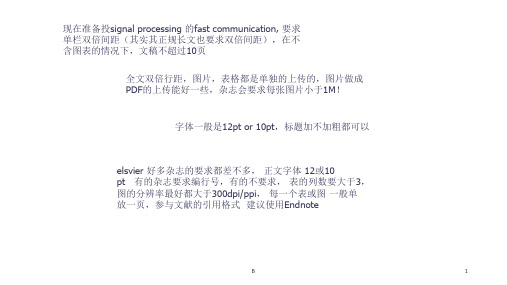
1)Elsevier对投稿的稿件格式要求比较松,投稿时选择“Your Paper Your Way”的方式即可。只要你投稿 时的稿件不影响审稿人阅读即可。也就是说你投稿时,直接把visio的图复制到word中就行了,调整好大 小,能看清楚,不影响正常阅读和读图。把所有的图和表按照行文组织穿插在正文中就行了。投初稿时 不用单独上传图、表等附件。只需要上传cover letter和manuscript即可。
B
5
表的要求是 : All tables are to be numbered using Arabic numerals. Tables should always be cited in text in consecutive numerical order. For each table, please supply a table caption (title) explaining the components of the table. Identify any previously published material by giving the original source in the form of a reference at the end of the table caption. Footnotes to tables should be indicated by superscript lower-case letters (or asterisks for significance values and other statistical data) and included beneath the table body.
如何使用Elsevier检索文献,及投稿(很有用!)
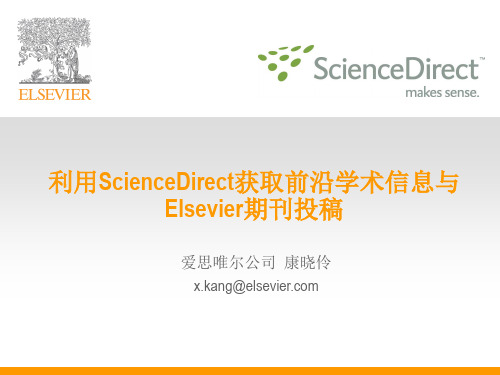
系统将稿件生成PDF文件
确认投稿
View Submission浏览文件确 定生成的PDF文档正确无误 接受“Ethics in Publishing” 点击“Approve Submission”
追踪稿件状态
追踪稿件状态
稿件修改
稿件是如何被评审的?
同行评审
同行评审的专家同时也是期刊的作者和读者 您可以推荐备选的评审专家 您的文章一般会交给2名评审人员 评审专家对您来说是匿名的 编辑和评审专家会确保您稿件内容不外泄 评审过程严格参照Guide for Authors
诺贝尔奖得主论文免费下载
/nobel2007.htm
更多信息请参考
/sdrevamp.htm
cninfo@ x.kang@
注册后, 可以使用更多其他个性化功能
注册后可以使用的所有个性化功能
追踪研究领域最新进展
期刊提示 检索提示 主题提示 引文提示 操作历史 快速链接 检索历史 检索保存
个性化主页
其他小工具
个性化主页
个人信息管理
个人信息管理
ห้องสมุดไป่ตู้
•Email提示管理 •个人帐户设置 • 更改密码 • 期刊内容报告
查看最热门文章排行
查看ScienceDirect文章下载次数排行 查看Scopus文章被引次数排行
查看SD上最热门的文章
Scopus: 分学科引用排行
免费资源:诺贝尔奖获奖作者文章
88%的诺贝尔物理奖得主 95%的诺贝尔化学奖得主 79%的诺贝尔医学奖得主 76%的诺贝尔经济学奖得主
Elsevier期刊网上投稿指南(中文版PDF)
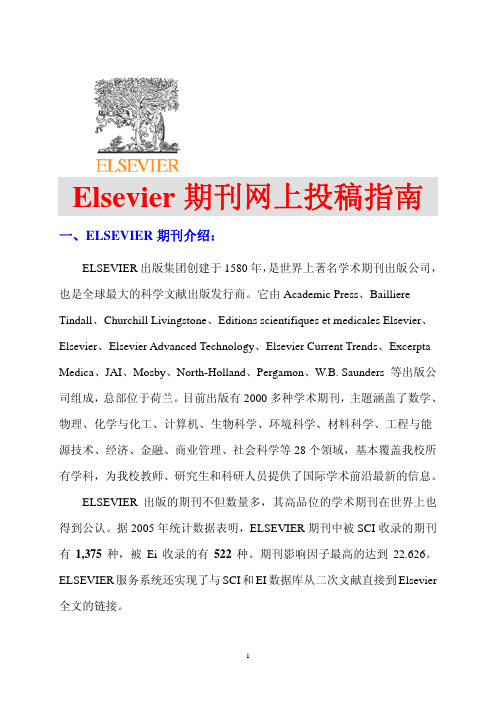
Elsevier期刊网上投稿指南一、ELSEVIER期刊介绍:ELSEVIER出版集团创建于1580年,是世界上著名学术期刊出版公司,也是全球最大的科学文献出版发行商。
它由Academic Press、Bailliere Tindall、Churchill Livingstone、Editions scientifiques et medicales Elsevier、Elsevier、Elsevier Advanced Technology、Elsevier Current Trends、Excerpta Medica、JAI、Mosby、North-Holland、Pergamon、W.B. Saunders 等出版公司组成,总部位于荷兰。
目前出版有2000多种学术期刊,主題涵盖了数学、物理、化学与化工、计算机、生物科学、环境科学、材料科学、工程与能源技术、经济、金融、商业管理、社会科学等28个領域,基本覆盖我校所有学科,为我校教师、研究生和科研人员提供了国际学术前沿最新的信息。
ELSEVIER出版的期刊不但数量多,其高品位的学术期刊在世界上也得到公认。
据2005年统计数据表明,ELSEVIER期刊中被SCI收录的期刊有1,375种,被Ei收录的有522种。
期刊影响因子最高的达到22.626。
ELSEVIER服务系统还实现了与SCI和EI数据库从二次文献直接到Elsevier 全文的链接。
目前,ELSEVIER出版集团在清华大学和上海交通大学图书馆设立镜像服务器,向校园网用户提供电子期刊全文数据库-ScienceDirect OnSite (SDOS)的服务;该站点装载了1995年以来该公司出版的1,774种电子期刊全文数据,文章篇数达2,731,1741篇。
读者也可以访问Elsevier美国主站点—ScienceDirect Online(SDOL)(/)。
SDOS和SDOL数据库均采用校园网范围的IP地址控制使用权限,不需要账号和口令,访问本地镜像和主站点都无需支付国际流量费。
Elsevier期刊投稿和投稿经验
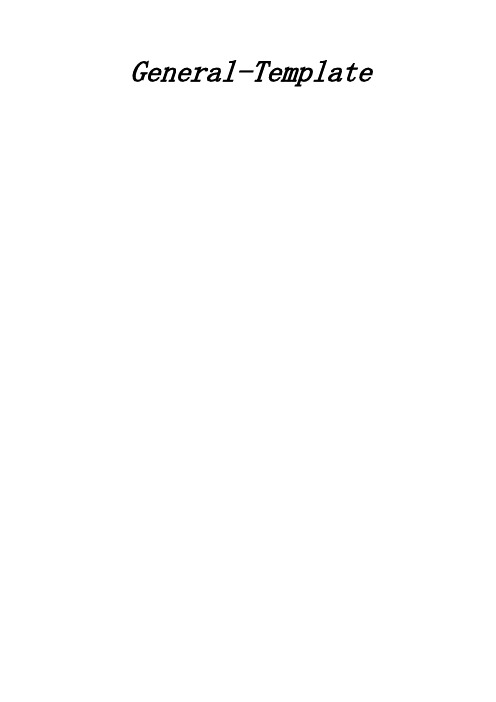
General-Template[Title Page]Article TitleAuthorsAuthor affiliationsCorrespondence information: Corresponding author name, affiliation, detailed permanent address, email address, telephone number(Check the Guide for authors to see the required information on the title page)Put the title of your abstract here using both upper and lower case letters, Times New Roman, 12?pts, bold, centered, double spacedA.?Author a,B.?Author b,C.?Author a,*a Department, University, Street, Postal-Code City, Countryb Laboratory, Institute, Street, Postal-Code City, CountryAbstractThis general template helps you on preparing manuscript for part of Elsevier Journals. Use this document as a template if you are using Microsoft Word 6.0 or later. Here comes self-contained abstract. Please read the Guide for Authors of your target journal for the requirements of Abstract. Pay special attention to the word count.PACS(optional, as per journal):Keywords:Keyword 1.D; Keyword 2.B (Read the Guide for Authors for the requirements for Keywords, including number, thesaurus, and classification indications)* Corresponding author. Tel.: +xx xxx xx xx; fax: +xx xxx xx xx.1. IntroductionThe manuscript should be prepared and submitted according to the Guide for Authors of your taget journal. . For your convenience, brief instructions on manuscript preparation are recorded below.Please DO consult a recent journal paper for style and conventions. You may find samples on ScienceDirect. You need to check your manuscript carefully before you submit it. The editor reserves the right to return manuscripts that do not conform to the instructions for manuscript preparation.2. General remarks on manuscript preparationGenerally, double line spacing, 12 pts font, and Times New Roman are preferred when you type the manuscript for review. This text formatting is provided in order to facilitate referee process and is also required for proper calculation of your manuscript length. Typing your manuscript follows the order: Title, Authors, Affiliations, Abstract, Keywords, Main text, Acknowledgements (optional), References (optional), Figure captions, Figures and Tables. Please consult the Guide for Authors for the proper organization of the main text. Ensure that each new paragraph is clearly indicated. Some journals also require lines to be numbered throughout the manuscript. You will usually want to divide your article into numbered sections and subsections. Present figures and tables at the right places mentioned in the Guide for Authors.Most formatting codes are removed or replaced while processing your article so there is no need for you to use excessive layout styling. Please do not use options such as automatic word breaking, double columns or automaticparagraph numbering (especially for numbered references). Do use bold face, italic, subscripts, superscripts, etc., as appropriate.2.1 IllustrationsMany journals required that figures and tables to be presented on separate pages at the end of the manuscript. The preferable file formats are: EPS (for vector graphics) and TIF (for bitmaps). However, PDF and MS Office (Word, Excel, Powerpoint figures) files are also acceptable. Use file names that enable to identify their contents in terms of figure number and format (e.g. fig1.tif, fig2.eps, fig3.pdf). All artwork has to be numbered according to its sequence in the text. All of them should have captions. Colour figures in printed version require an extra fee for most journals. Generally, no vertical rules (lines) should be used in tables. Illustrations should not duplicate descriptions that appear elsewhere in the manuscript.Please look at for more detailed instructions on artwork preparations.2.2 EquationsConventionally, in mathematical equations variables and anything thatrepresents a value appear in italics. You are encouraged to use equation-editing tools such as mathtype to edit equations. Please make use of the numbering and referencing functions.2.3 CitationsThere are different styles of in-text citations and reference lists. DO consult the Guide for Authors to see the given examples. Pay special attentionto the format of author names, journal names, publication year, volume and page span.AcknowledgementsThis section is optional.References[1].[2].Figure CaptionsFig.1 Put at this page the collected figure captions. The figure captions should be as brief as possible. It should also contain sufficient information that readers do not need to refer to the main text.Fig.2 Put here the figure caption of figure 2 (also the legend to figure 2). Fig. 3Fig.?1. Sample figure. Do not reduce or enlarge any images after placement in an MS Office application as this can lead to loss of image quality. While inserting vector graphics ensure that you use only truetype fonts. These should preferably be in one, or a combination, of the following fonts: Arial, Courier, Helvetica, Symbol, Times.Table 1Sample table: (使用三线表)a(Å) 4.5832 4.9365 Δ E a (eV) 1.745 1.592 ………………a This is an example of a table footnote.关于Elsevier旗下期刊投稿1 关于Elsevier旗下期刊投稿概述(1) Elsevier旗下共有1300多种期刊。
Elsevier上发表论文的作者须知
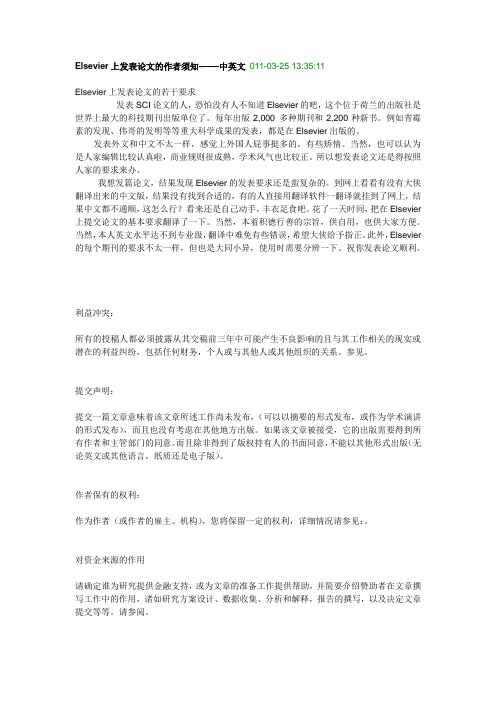
Elsevier上发表论文的作者须知-——中英文011-03-25 13:35:11Elsevier上发表论文的若干要求发表SCI论文的人,恐怕没有人不知道Elsevier的吧,这个位于荷兰的出版社是世界上最大的科技期刊出版单位了。
每年出版2,000 多种期刊和2,200种新书。
例如青霉素的发现、伟哥的发明等等重大科学成果的发表,都是在Elsevier出版的。
发表外文和中文不太一样,感觉上外国人屁事挺多的,有些矫情。
当然,也可以认为是人家编辑比较认真啦,商业规则很成熟,学术风气也比较正。
所以想发表论文还是得按照人家的要求来办。
我想发篇论文,结果发现Elsevier的发表要求还是蛮复杂的。
到网上看看有没有大侠翻译出来的中文版,结果没有找到合适的,有的人直接用翻译软件一翻译就挂到了网上,结果中文都不通顺,这怎么行?看来还是自己动手,丰衣足食吧。
花了一天时间,把在Elsevier 上提交论文的基本要求翻译了一下。
当然,本着积德行善的宗旨,供自用,也供大家方便。
当然,本人英文水平达不到专业级,翻译中难免有些错误,希望大侠给予指正。
此外,Elsevier 的每个期刊的要求不太一样,但也是大同小异,使用时需要分辨一下。
祝你发表论文顺利。
利益冲突:所有的投稿人都必须披露从其交稿前三年中可能产生不良影响的且与其工作相关的现实或潜在的利益纠纷,包括任何财务,个人或与其他人或其他组织的关系。
参见。
提交声明:提交一篇文章意味着该文章所述工作尚未发布,(可以以摘要的形式发布,或作为学术演讲的形式发布),而且也没有考虑在其他地方出版。
如果该文章被接受,它的出版需要得到所有作者和主管部门的同意。
而且除非得到了版权持有人的书面同意,不能以其他形式出版(无论英文或其他语言,纸质还是电子版)。
作者保有的权利:作为作者(或作者的雇主、机构),您将保留一定的权利,详细情况请参见:。
对资金来源的作用请确定谁为研究提供金融支持,或为文章的准备工作提供帮助,并简要介绍赞助者在文章撰写工作中的作用,诸如研究方案设计、数据收集、分析和解释,报告的撰写,以及决定文章提交等等。
Elsevier投稿指南
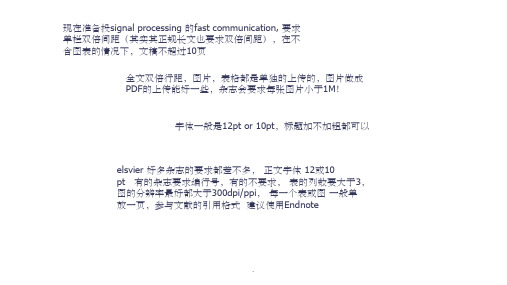
现在准备投signal processing 的fast communication, 要求 单栏双倍间距(其实其正规长文也要求双倍间距),在不 含图表的情况下,文稿不超过10页
全文双倍行距,图片,表格都是单独的上传的,图片做成 PDF的上传能好一些,杂志会要求每张图片小于1M!
字体一般是12pt or 10pt,标题加不加粗都可以
Typing your manuscript follows the order: Title, Author Affiliations, Abstract, Keywords, Main text, Acknowled (optional), References (optional), Figure captions, Figur Tables.
elsvier 好多杂志的要求都差不多, 正文字体 12或10 pt 有的杂志要求编行号,有的不要求, 表的列数要大于3, 图的分辨率最好都大于300dpi/ppi, 每一个表或图 一般单 放一页,参与文献的引用格式 建议使用Endnote
Elsevier期刊投稿模板与 投稿经验
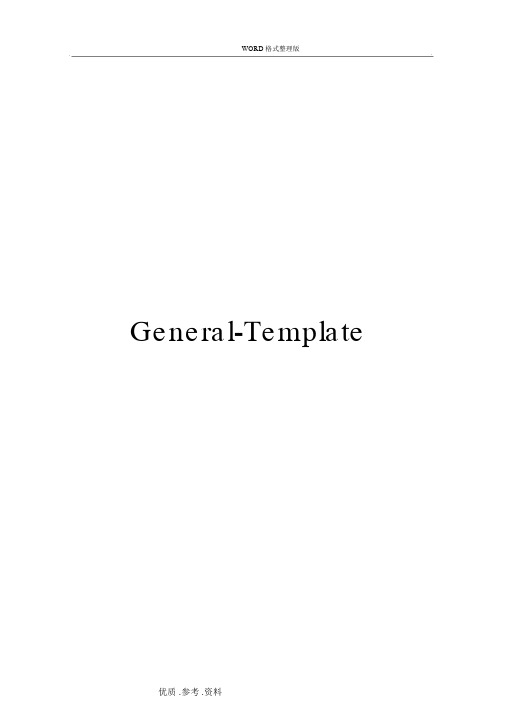
WORD 格式整理版General-Template[Title Page]Article TitleAuthorsAuthor affiliationsCorrespondence information: Corresponding author name, affiliation, detailed permanent address, email address, telephone number(Check the Guide for authors to see the required information on thetitle page)Put the title of your abstract here using both upper and lower caseletters, Times New Roman, 12pts, bold, centered, double spacedA. Author a,B.Author b,C.Author a,*a Department, University, Street, Postal-Code City, Countryb Laboratory, Institute, Street, Postal-Code City, CountryAbstractThis general template helps you on preparing manuscript for part ofElsevier Journals. Use this document as a template if you are usingMicrosoft Word 6.0 or later.Here comes self-contained abstract. Please read the Guide for Authors of your t arget journal for the requirements of Abstract. Pay special attention to the word count.PACS(optional, as per journal):75.40.-s; 71.20.LPKeywords: Keyword 1.D; Keyword 2.B (Read the Guide for Authors for therequirements for Keywords,including number,thesaurus,and classification indications)*Corresponding author. Tel.: +xx xxx xx xx; fax: +xx xxx xx xx. E-mail address: xxxxx@xxx.xx1. IntroductionThe manuscript should be prepared and submitted according to the Guide for Authors of your taget journal. . For your convenience, briefinstructions on manuscript preparation are recorded below.Please DO consult a recent journal paper for style and conventions.You may find samples on ScienceDirect . You need to check your manuscript carefully before you submit it.The editor reserves theright to return manuscripts that do not conform to the instructionsfor manuscript preparation.2. General remarks on manuscript preparationGenerally, double line spacing, 12 pts font, and Times New Roman arepreferred when you type the manuscript for review.This text formatting is provided in order to facilitate referee process and isalso required for proper calculation of your manuscript length. Typingyour manuscript follows the order:Title,Authors,Affiliations,Abstract, Keywords, Main text, Acknowledgements (optional), References(optional),Figure captions,Figures and Tables.Please consult the Guide for Authors for the proper organization of the main text. Ensurethat each new paragraph is clearly indicated.Some journals alsorequire lines to be numbered throughout the manuscript.You will usually want to divide your article into numbered sections and subsections. Present figures and tables at the right places mentionedin the Guide for Authors.Most formatting codes are removed or replaced while processing your article so there is no need for you to use excessive layout styling.Please do not use options such as automatic word breaking, double columns or automatic paragraph numbering(especially for numbered references).Do use bold face,italic,subscripts, superscripts, etc., as appropriate.2.1 IllustrationsMany journals required that figures and tables to be presented on separate pages at the end of the manuscript.The preferable file formats are: EPS (for vector graphics) and TIF (for bitmaps). However,PDF and MS Office(Word,Excel,Powerpoint figures)files are also e file names that enable to identify their contents in terms of figure number and format (e.g. fig1.tif, fig2.eps, fig3.pdf).All artwork has to be numbered according to its sequence in the text.All of them should have captions.Colour figures in printed version require an extra fee for most journals.Generally,no vertical rules(lines)should be used in tables. Illustrations should not duplicatedescriptions that appear elsewhere in the manuscript.Please look at /wps/find/authors.authors/authorartworkinstructions for more detailed instructions on artwork preparations.2.2 EquationsConventionally,in mathematical equations variables and anything thatrepresents a value appear in italics.You are encouraged to use equation-editing tools such as mathtype to edit equations. Please makeuse of the numbering and referencing functions.2.3 CitationsThere are different styles of in-text citations and reference lists.DO consult the Guide for Authors to see the given examples.Payspecial attention to the format of author names, journal names,publication year, volume and page span.AcknowledgementsThis section is optional.References[1].[2].Figure CaptionsFig.1 Put at this page the collected figure captions.The figurecaptions should be as brief as possible.It should also contain sufficient information that readers do not need to refer to the main text.Fig.2 Put here the figure caption of figure 2 (also the legend to figure 2).Fig. 3WORD 格式整理版Fig. 1.Sample figure.Do not reduce or enlarge any images after placement in an MS Office application as this can lead to loss of image quality.While inserting vector graphics ensure that you use only truetype fonts.These should preferably be in one,or a combination, of the following fonts: Arial, Courier, Helvetica, Symbol,Times.WORD 格式整理版Table 1Sample table: (使用三线表 )Parameter Compound 1Compound 2 a ( ? ) 4.5832 4.9365E a (eV) 1.745 1.592⋯⋯⋯⋯⋯⋯a This is an example of a table footnote.关于 Elsevier 旗下期刊投稿 1 关于 Elsevier旗下期刊投稿概述(1)Elsevier旗下共有 1300 多种期刊。
Elsevier投稿的一些问题-推荐下载
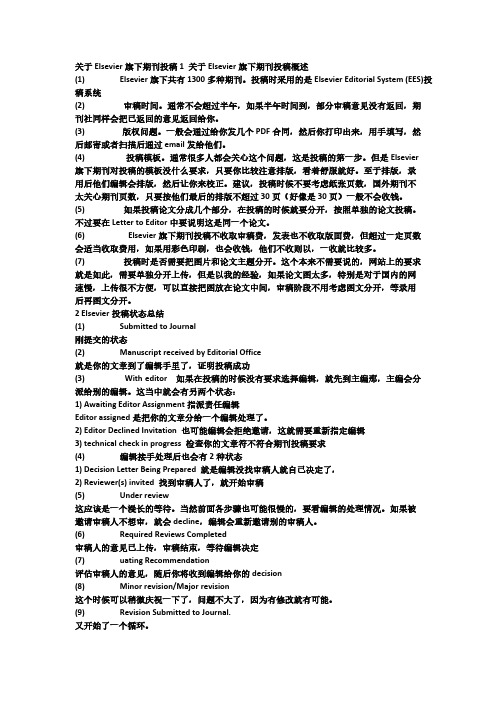
关于Elsevier旗下期刊投稿1 关于Elsevier旗下期刊投稿概述(1) Elsevier旗下共有1300多种期刊。
投稿时采用的是Elsevier Editorial System (EES)投稿系统(2) 审稿时间。
通常不会超过半年,如果半年时间到,部分审稿意见没有返回,期刊社同样会把已返回的意见返回给你。
(3) 版权问题。
一般会通过给你发几个PDF合同,然后你打印出来,用手填写,然后邮寄或者扫描后通过email发给他们。
(4) 投稿模板。
通常很多人都会关心这个问题,这是投稿的第一步。
但是Elsevier旗下期刊对投稿的模板没什么要求,只要你比较注意排版,看着舒服就好。
至于排版,录用后他们编辑会排版,然后让你来校正。
建议,投稿时候不要考虑纸张页数,国外期刊不太关心期刊页数,只要按他们最后的排版不超过30页(好像是30页)一般不会收钱。
(5) 如果投稿论文分成几个部分,在投稿的时候就要分开,按照单独的论文投稿。
不过要在Letter to Editor中要说明这是同一个论文。
(6) Elsevier旗下期刊投稿不收取审稿费,发表也不收取版面费,但超过一定页数会适当收取费用,如果用彩色印刷,也会收钱,他们不收则以,一收就比较多。
(7) 投稿时是否需要把图片和论文主题分开。
这个本来不需要说的,网站上的要求就是如此,需要单独分开上传,但是以我的经验,如果论文图太多,特别是对于国内的网速慢,上传很不方便,可以直接把图放在论文中间,审稿阶段不用考虑图文分开,等录用后再图文分开。
2 Elsevier投稿状态总结(1) Submitted to Journal刚提交的状态(2) Manuscript received by Editorial Office就是你的文章到了编辑手里了,证明投稿成功(3) With editor 如果在投稿的时候没有要求选择编辑,就先到主编那,主编会分派给别的编辑。
这当中就会有另两个状态:1) Awaiting Editor Assignment指派责任编辑Editor assigned是把你的文章分给一个编辑处理了。
SCI 论文投稿全过程(Elsevier在线投递)
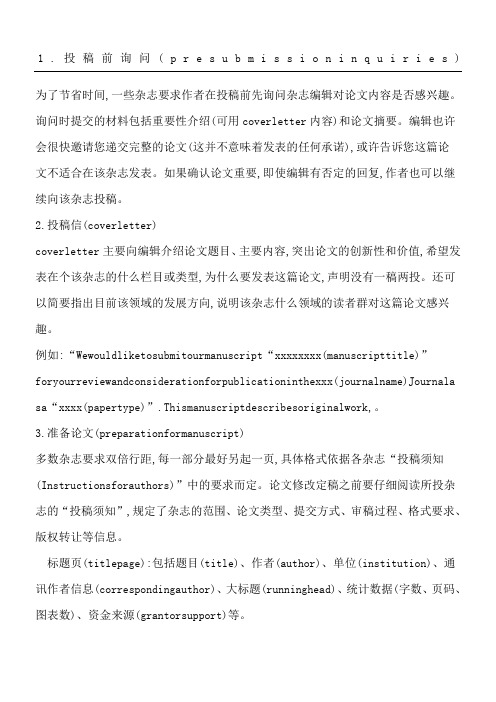
1.投稿前询问(p r e s u b m i s s i o n i n q u i r i e s)为了节省时间,一些杂志要求作者在投稿前先询问杂志编辑对论文内容是否感兴趣。
询问时提交的材料包括重要性介绍(可用coverletter内容)和论文摘要。
编辑也许会很快邀请您递交完整的论文(这并不意味着发表的任何承诺),或许告诉您这篇论文不适合在该杂志发表。
如果确认论文重要,即使编辑有否定的回复,作者也可以继续向该杂志投稿。
2.投稿信(coverletter)coverletter主要向编辑介绍论文题目、主要内容,突出论文的创新性和价值,希望发表在个该杂志的什么栏目或类型,为什么要发表这篇论文,声明没有一稿两投。
还可以简要指出目前该领域的发展方向,说明该杂志什么领域的读者群对这篇论文感兴趣。
例如:“Wewouldliketosubmitourmanuscript“xxxxxxxx(manuscripttitle)”foryourreviewandconsiderationforpublicationinthexxx(journalname)Journala sa“xxxx(papertype)”.Thismanuscriptdescribesoriginalwork,。
3.准备论文(preparationformanuscript)多数杂志要求双倍行距,每一部分最好另起一页,具体格式依据各杂志“投稿须知(Instructionsforauthors)”中的要求而定。
论文修改定稿之前要仔细阅读所投杂志的“投稿须知”,规定了杂志的范围、论文类型、提交方式、审稿过程、格式要求、版权转让等信息。
标题页(titlepage):包括题目(title)、作者(author)、单位(institution)、通讯作者信息(correspondingauthor)、大标题(runninghead)、统计数据(字数、页码、图表数)、资金来源(grantorsupport)等。
Elsevier投稿的一些问题
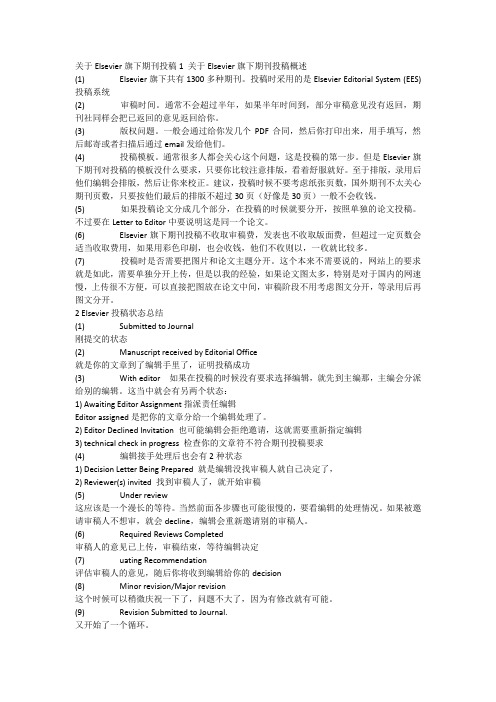
关于Elsevier旗下期刊投稿1 关于Elsevier旗下期刊投稿概述(1) Elsevier旗下共有1300多种期刊。
投稿时采用的是Elsevier Editorial System (EES)投稿系统(2) 审稿时间。
通常不会超过半年,如果半年时间到,部分审稿意见没有返回,期刊社同样会把已返回的意见返回给你。
(3) 版权问题。
一般会通过给你发几个PDF合同,然后你打印出来,用手填写,然后邮寄或者扫描后通过email发给他们。
(4) 投稿模板。
通常很多人都会关心这个问题,这是投稿的第一步。
但是Elsevier旗下期刊对投稿的模板没什么要求,只要你比较注意排版,看着舒服就好。
至于排版,录用后他们编辑会排版,然后让你来校正。
建议,投稿时候不要考虑纸张页数,国外期刊不太关心期刊页数,只要按他们最后的排版不超过30页(好像是30页)一般不会收钱。
(5) 如果投稿论文分成几个部分,在投稿的时候就要分开,按照单独的论文投稿。
不过要在Letter to Editor中要说明这是同一个论文。
(6) Elsevier旗下期刊投稿不收取审稿费,发表也不收取版面费,但超过一定页数会适当收取费用,如果用彩色印刷,也会收钱,他们不收则以,一收就比较多。
(7) 投稿时是否需要把图片和论文主题分开。
这个本来不需要说的,网站上的要求就是如此,需要单独分开上传,但是以我的经验,如果论文图太多,特别是对于国内的网速慢,上传很不方便,可以直接把图放在论文中间,审稿阶段不用考虑图文分开,等录用后再图文分开。
2 Elsevier投稿状态总结(1) Submitted to Journal刚提交的状态(2) Manuscript received by Editorial Office就是你的文章到了编辑手里了,证明投稿成功(3) With editor如果在投稿的时候没有要求选择编辑,就先到主编那,主编会分派给别的编辑。
这当中就会有另两个状态:1) Awaiting Editor Assignment指派责任编辑Editor assigned是把你的文章分给一个编辑处理了。
Elsevier投稿的一些问题
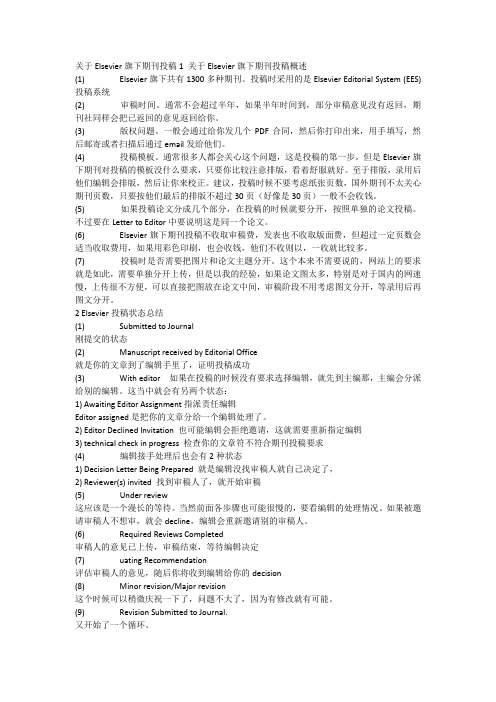
关于Elsevier旗下期刊投稿1 关于Elsevier旗下期刊投稿概述(1) Elsevier旗下共有1300多种期刊。
投稿时采用的是Elsevier Editorial System (EES)投稿系统(2) 审稿时间。
通常不会超过半年,如果半年时间到,部分审稿意见没有返回,期刊社同样会把已返回的意见返回给你。
(3) 版权问题。
一般会通过给你发几个PDF合同,然后你打印出来,用手填写,然后邮寄或者扫描后通过email发给他们。
(4) 投稿模板。
通常很多人都会关心这个问题,这是投稿的第一步。
但是Elsevier旗下期刊对投稿的模板没什么要求,只要你比较注意排版,看着舒服就好。
至于排版,录用后他们编辑会排版,然后让你来校正。
建议,投稿时候不要考虑纸张页数,国外期刊不太关心期刊页数,只要按他们最后的排版不超过30页(好像是30页)一般不会收钱。
(5) 如果投稿论文分成几个部分,在投稿的时候就要分开,按照单独的论文投稿。
不过要在Letter to Editor中要说明这是同一个论文。
(6) Elsevier旗下期刊投稿不收取审稿费,发表也不收取版面费,但超过一定页数会适当收取费用,如果用彩色印刷,也会收钱,他们不收则以,一收就比较多。
(7) 投稿时是否需要把图片和论文主题分开。
这个本来不需要说的,网站上的要求就是如此,需要单独分开上传,但是以我的经验,如果论文图太多,特别是对于国内的网速慢,上传很不方便,可以直接把图放在论文中间,审稿阶段不用考虑图文分开,等录用后再图文分开。
2 Elsevier投稿状态总结(1) Submitted to Journal刚提交的状态(2) Manuscript received by Editorial Office就是你的文章到了编辑手里了,证明投稿成功(3) With editor如果在投稿的时候没有要求选择编辑,就先到主编那,主编会分派给别的编辑。
这当中就会有另两个状态:1) Awaiting Editor Assignment指派责任编辑Editor assigned是把你的文章分给一个编辑处理了。
elsevier期刊投稿须知

/infman/登录系统/wps/find/journaldescription.cws_home/505553/authorinstructions用户投稿手册Use of wordprocessing softwareIt is important that the file be saved in the native format of the wordprocessor used. The text should be in single-column format.Keep the layout of the text as simple as possible. Most formatting codes will be removed and replaced on processing the article. In particular, do not use the wordprocessor's options to justify text or to hyphenate words. However, do use bold face, italics, subscripts, superscripts etc. When preparing tables, if you are using a table grid, u se only one grid for each individual table and not a grid for each row. If no grid is used, use tabs, not spaces, to align columns. The electronic text should be prepared in a way very similar to that of conventional manuscripts (see also the Guide to Publishing with Elsevier: /guidepublication). Note that source files of figures, tables and text graphics will be required whether or not you embed your figures in the text. See also the section on Electronic artwork.To avoid unnecessary errors you are strongly advised to use the 'spell-check' and 'grammar-check' functions of your wordprocessor.Article structureAuthors should use a scientific/engineering attitude towards their analyses. The numbers computed should have the appropriate number of significant figures. Please do not use more significant figures than the observations allow (i.e., for most surveys 2 or 3 are sufficient). Decimal fractions should have a leading zero, e.g. 0.001 rather than .001Authors are encouraged to look at the articles recently published inthe journal to understand the aims of the journal.Essential title page information• Title.Concise and informative. Titles are often used in information-retrieval systems. Avoid abbreviations and formulae where possible.• Author names and affiliations.Where the family name may be ambiguous (e.g., a double name), please indicate this clearly. Present the authors' affiliation addresses (where the actual work was done) below the names. Indicate all affiliations with a lower-case superscript letter immediately after the author's name and in front of the appropriate address. Provide the full postal address of each affiliation, including the country name and,if available, the e-mail address of each author.• Corresponding author.Clearly indicate who will handle correspondence at all stages of refereeing and publication, also post-publication. Ensure thattelephone and fax numbers (with country and area code) are provided in addition to the e-mail address and the complete postal address. Contact details must be kept up to date by the corresponding author.• Present/permanent address.If an author has moved since the work described in the article was done, or was visiting at the time, a 'Present address' (or 'Permanent address') may be indicated as a footnote to that author's name. The address at which the author actually did the work must be retained as the main, affiliation address. Superscript Arabic numerals are used for such footnotes.AbstractA concise and factual abstract is required. The abstract should state briefly the purpose of the research, the principal results and major conclusions. An abstract is often presented separately from the article, so it must be able to stand alone. For this reason, References should be avoided, but if essential, then cite the author(s) and year(s). Also, non-standard or uncommon abbreviations should be avoided, but if essential they must be defined at their first mention in the abstract itself.The abstract should not be more than 100 words.KeywordsThe first page of the manuscript should also contain a short list of carefully chosen keywords or content indicators.AcknowledgementsCollate acknowledgements in a separate section at the end of the article before the references and do not, therefore, include them on the title page, as a footnote to the title or otherwise. List here those individuals who provided help during the research (e.g., providing language help, writing assistance or proof reading the article, etc.).ArtworkElectronic artworkGeneral points• Make sure you use uniform lettering and sizing of your original artwork.字体和字号一致• Save text in illustrations as 'graphics' or enclose the font.• Only use th e following fonts in your illustrations: Arial, Courier, Times, Symbol.插图字体• Number the illustration s according to their sequence in the text.插图安先后顺序排序• Use a logical naming convention for your artwork files.• Provide captions to illustrations separately.插图说明• Produce images near to the desired size of the printed version.• Submit each figure as a separate file.分别提交插图A detailed guide on electronic artwork is available on our website:/artworkinstructionsYou are urged to visit this site; some excerpts from the detailed information are given here.FormatsRegardless of the application used, when your electronic artwork is finalised, please 'save as' or convert the images to one of the following formats (note the resolution requirements for line drawings, halftones, and line/halftone combinations given below):EPS: Vector drawings. Embed the font or save the text as 'graphics'.TIFF: Color or grayscale photographs (halftones): always use a minimum of 300 dpi.TIFF: Bitmapped line drawings: use a minimum of 1000 dpi.TIFF: Combinations bitmapped line/half-tone (color or grayscale): a minimum of 500 dpi is required.If your electronic artwork is created in a Microsoft Office application (Word, PowerPoint, Excel) then please supply 'as is'.Please do not:• Supply files that are optimised for screen use (e.g., GIF, BMP, PICT, WPG); the resolution is too low;• Supply files that a re too low in resolution;• Submit graphics that are disproportionately large for the content.Color artworkPlease make sure that artwork files are in an acceptable format (TIFF, EPS or MS Office files) and with the correct resolution. If, together with your accepted article, you submit usable color figures then Elsevier will ensure, at no additional charge, that these figures will appear in color on the Web (e.g., ScienceDirect and other sites) regardless of whether or not these illustrations are reproduced in color in the printed version. For color reproduction in print, you will receive information regarding the costs from Elsevier after receipt of your accepted article. Please indicate your preference for color: in print or on the Web only. For further information on the preparation of electronic artwork, please see /artworkinstructions.Please note: Because of technical complications which can arise by convertingcolor figures to 'gray scale' (for the printed version should you not opt for color in print) please submit in addition usable black and white versions of all the color illustrations.Figure captionsEnsure that each illustration has a caption. Supply captions separately, not attached to the figure. A caption should comprise a brief title (not on the figure itself) and a description of the illustration. Keep text in the illustrations themselves to a minimum but explain all symbols and abbreviations used.Text graphicsText graphics may be embedded in the text at the appropriate position. Further, high-resolution graphics files must be provided separately whether or not the graphics are embedded. See further under Electronic artwork.TablesNumber tables consecutively in accordance with their appearance in the text. Place footnotes to tables below the table body and indicate them with superscript lowercase letters. Avoid vertical rules. Be sparing in the use of tables and ensure that the data presented in tables do not duplicate results described elsewhere in the article.ReferencesCitation in textPlease ensure that every reference cited in the text is also present in the reference list (and vice versa). Any references cited in the abstract must be given in full. Unpublished results and personal communications are not recommended in the reference list, but may be mentioned in the text. If these references are included in the reference list they should follow the standard reference style of the journal and should include a substitution of the publication date with either 'Unpublished results' or 'Personal communication'. Citation of a reference as 'in press' implies that the item has been accepted for publication.Citations to well known facts, statistical and psychological documents, mathematical techniques or articles more than eight years old should, in general, be avoided.Web referencesAs a minimum, the full URL should be given and the date when the reference was last accessed. Any further information, if known (DOI, author names, dates, reference to a source publication, etc.), should also be given. Web references can be listed separately (e.g., after the reference list) under a different headingif desired, or can be included in the reference list.Please only refer to peer reviewed articles.References in a special issuePlease ensure that the words 'this issue' are added to any references in the list (and any citations in the text) to other articles in the same Special Issue. Reference management softwareThis journal has standard templates available in key reference management packages EndNote (/support/enstyles.asp) and Reference Manager (/support/rmstyles.asp). Using plug-ins to wordprocessing packages, authors only need to select the appropriate journal template when preparing their article and the list of references and citations to these will be formatted according to the journal style which is described below.Reference styleText: Indicate references by number(s) in square brackets in line with the text. The actual authors can be referred to, but the reference number(s) must always be given.Example: '..... as demonstrated [3,6]. Barnaby and Jones [8] obtained a different result ....'List: Number the references (numbers in square brackets) in the list in the order in which they appear in the text.Examples:Reference to a journal publication:[1] J. van der Geer, J.A.J. Hanraads, R.A. Lupton, The art of writing a scientific article, J. Sci. Commun. 163 (2010) 51–59.Reference to a book:[2] W. Strunk Jr., E.B. White, The Elements of Style, fourth ed., Longman, New York, 2000.Reference to a chapter in an edited book:[3] G.R. Mettam, L.B. Adams, How to prepare an electronic version of your article, in: B.S. Jones, R.Z. Smith (Eds.), Introduction to the Electronic Age, E-Publishing Inc., New York, 2009, pp. 281–304.Journal abbreviations sourceJournal names should be abbreviated according toIndex Medicus journal abbreviations:/tsd/serials/lji.html;List of title word abbreviations:/2-22661-LTWA-online.php;CAS (Chemical Abstracts Service): /sent.html.Video dataElsevier accepts video material and animation sequences to support and enhance your scientific research. Authors who have video or animation files that they wish to submit with their article are strongly encouraged to include these within the body of the article. This can be done in the same way as a figure or table by referring to the video or animation content and noting in the body text where it should be placed. All submitted files should be properly labeled so that they directly relate to the video file's content. In order to ensure that your video or animation material is directly usable, please provide the files in one of our recommended file formats with a preferred maximum size of 50 MB. Video and animation files supplied will be published online in the electronic version of your article in Elsevier Web products, including ScienceDirect: . Please supply 'stills' with your files: you can choose any frame from the video or animation or make a separate image. These will be used instead of standard icons and will personalize the link to your video data. For more detailed instructions please visit our video instruction pages at /artworkinstructions. Note: since video and animation cannot be embedded in the print version of the journal, please provide text for both the electronic and the print version for the portions of the article that refer to this content.Supplementary dataElsevier accepts electronic supplementary material to support and enhance your scientific research. Supplementary files offer the author additional possibilities to publish supporting applications, high-resolution images, background datasets, sound clips and more. Supplementary files supplied will be published online alongside the electronic version of your article in Elsevier Web products, including ScienceDirect: . In order to ensure that your submitted material is directly usable, please provide the data in one of our recommended file formats. Authors should submit the material in electronic format together with the article and supply a concise and descriptive caption for each file. For more detailed instructions please visit our artwork instruction pages at /artworkinstructions.Submission checklistThe following list will be useful during the final checking of an article prior to sending it to the journal for review. Please consult this Guide for Authors for further details of any item.Ensure that the following items are present:One author has been designated as the corresponding author with contactdetails:• E-mail address• Full postal address• Telephone and fax numbersAll necessary files have been uploaded, and contain:• Keywords• All figure captions• All tables (including title, description, footnotes)Further considerations• Manuscript has been 'spell-checked' and 'grammar-checked'• References are in the correct format for this journal• All references mentioned in the Reference list are cited in the text, and vice versa• Permission has been obtained f or use of copyrighted material from other sources (including the Web)• Color figures are clearly marked as being intended for color reproduction on the Web (free of charge) and in print, or to be reproduced in color on the Web (free of charge) and in black-and-white in print• If only color on the Web is required, black-and-white versions of the figures are also supplied for printing purposesFor any further information please visit our customer support site at ./locate/dss/decsup/default.asp?pg=login.asp陆系统/wps/find/journaldescription.cws_home/505540/authorinstructions#N1 0D2B投稿须知,包含内容:这三项内容需上传Covering Letter ,Highlights ,Manuscript ,Biographical NoteComments,reviewerInformation要求:1,摘要100字,实际272字;2,需要推荐两位评审;3,Comments内容;4,DSS20121007是投Dss的,还是投I&M;我看DSS20121007的作者有邓贵仕老师,而JOC20121007里面的文章有Chuanren Liu。
Elsevier投稿指南

B
5
表的要求是 : All tables are to be numbered using Arabic numerals. Tables should always be cited in text in consecutive numerical order. For each table, please supply a table caption (title) explaining the components of the table. Identify any previously published material by giving the original source in the form of a reference at the end of the table caption. Footnotes to tables should be indicated by superscript lower-case letters (or asterisks for significance values and other statistical data) and included beneath the table body.
现在准备投signal processing 的fast communication, 要求 单栏双倍间距(其实其正规长文也要求双倍间距),在不 含图表的情况下,文稿不超过10页
全文双倍行距,图片,表格都是单独的上传的,图片做成 PDF的上传能好一些,杂志会要求每张图片小于1M!
字体一般是12pt or 10pt,标题加不加粗都可以
1)Elsevier对投稿的稿件格式要求比较松,投稿时选择“Your Paper Your Way”的方式即可。只要你投稿 时的稿件不影响审稿人阅读即可。也就是说你投稿时,直接把visio的图复制到word中就行了,调整好大 小,能看清楚,不影响正常阅读和读图。把所有的图和表按照行文组织穿插在正文中就行了。投初稿时 不用单独上传图、表等附件。只需要上传cover letter和manuscript即可。
论文投稿注意事项-爱思维尔专家总结

论文投稿注意事项-爱思维尔专家总结Title, Author and Affiliation_ 文题:简洁、清楚、充分地表达文章内容,避免无意义的词_ 作者:指明通讯作者。
确认所有作者都对文章作出了贡献,并同意发表文章_ 作者排序:_ 第一作者是对数据收集和分析以及论文撰写负有主要责任的人_ 最后一位作者,通常是有学术地位的研究人员,对整个研究负有责任;_ 位列中间者的顺序则视其对研究所做出的贡献而定_ 通讯作者的排名是不重要的,但一旦选择成为了通讯作者,就要对这篇文章在审阅过程中的所有通信交流质询做出负责的回应。
_ 作者机构:所有作者的机构信息Abstract_ 简要介绍文章内容和研究目的_ 关键结论的简要描述_ 不要涉及太多的实验细节_ 不超过250字_ 摘要是论文最先被阅读的部分_ 摘要,题名含混不清/不科学论文的缩微模型:做了什么,得到了哪些重要结果Abstract.I&M = 做了什么I---We tackle the general linear instantaneous model (possibly underdetermined and noisy) where we model the source prior with a Student t distribution. The conjugate-exponential characterisation ofthe t distribution as an infinite mixture of scaled Gaussians enables usto do efficient inference. M---We study two well-known inference methods, Gibbs sampler and variational Bayes for Bayesian source separation.We derive both techniques as local message passing algorithms to highlight their algorithmic similarities and to contrast their different convergence characteristics and computational requirements.R&D=主要发现是什么R---Our simulation results suggest that typical posterior distributions in source separation have multiple local maxima. Therefore we proposea hybrid approach where we explore the state space with a Gibbssampler and then switch to a deterministic algorithm. D---This approach seems to be able to combine the speed of the variational approachwith the robustness of the Gibbs sampler.Introduction简短,重点突出_ 研究的重要性_ What is the problem?_ Are there any existing solutions?_ Which is the best?_ What is its main limitation?_ What do you hope to achieve?注意:论述问题、研究目的及研究方法,但不要说明结论、展开讨论或进行总结(应包含在Abstract中)_ 引用对应领域重要的及最新的著作(30篇以内)_ 评审人员评审角度_ 有效性、论述清楚、内容组织_ 相关重要的文献是否包含Methods_ 基本原则:提供足够的信息,以便读者能够重复试验或推倒的过程。
Elsevier上发表论文的若干要求
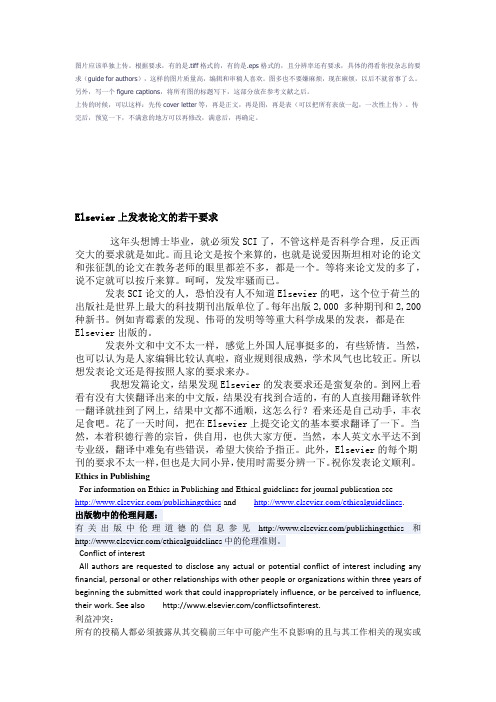
图片应该单独上传。
根据要求,有的是.tiff格式的,有的是.eps格式的,且分辨率还有要求,具体的得看你投杂志的要求(guide for authors),这样的图片质量高,编辑和审稿人喜欢。
图多也不要嫌麻烦,现在麻烦,以后不就省事了么。
另外,写一个figure captions,将所有图的标题写下,这部分放在参考文献之后。
上传的时候,可以这样:先传cover letter等,再是正文,再是图,再是表(可以把所有表放一起,一次性上传)。
传完后,预览一下,不满意的地方可以再修改,满意后,再确定。
Elsevier上发表论文的若干要求这年头想博士毕业,就必须发SCI了,不管这样是否科学合理,反正西交大的要求就是如此。
而且论文是按个来算的,也就是说爱因斯坦相对论的论文和张征凯的论文在教务老师的眼里都差不多,都是一个。
等将来论文发的多了,说不定就可以按斤来算。
呵呵,发发牢骚而已。
发表SCI论文的人,恐怕没有人不知道Elsevier的吧,这个位于荷兰的出版社是世界上最大的科技期刊出版单位了。
每年出版2,000 多种期刊和2,200种新书。
例如青霉素的发现、伟哥的发明等等重大科学成果的发表,都是在Elsevier出版的。
发表外文和中文不太一样,感觉上外国人屁事挺多的,有些矫情。
当然,也可以认为是人家编辑比较认真啦,商业规则很成熟,学术风气也比较正。
所以想发表论文还是得按照人家的要求来办。
我想发篇论文,结果发现Elsevier的发表要求还是蛮复杂的。
到网上看看有没有大侠翻译出来的中文版,结果没有找到合适的,有的人直接用翻译软件一翻译就挂到了网上,结果中文都不通顺,这怎么行?看来还是自己动手,丰衣足食吧。
花了一天时间,把在Elsevier上提交论文的基本要求翻译了一下。
当然,本着积德行善的宗旨,供自用,也供大家方便。
当然,本人英文水平达不到专业级,翻译中难免有些错误,希望大侠给予指正。
此外,Elsevier的每个期刊的要求不太一样,但也是大同小异,使用时需要分辨一下。
Elsevier投稿的一些问题
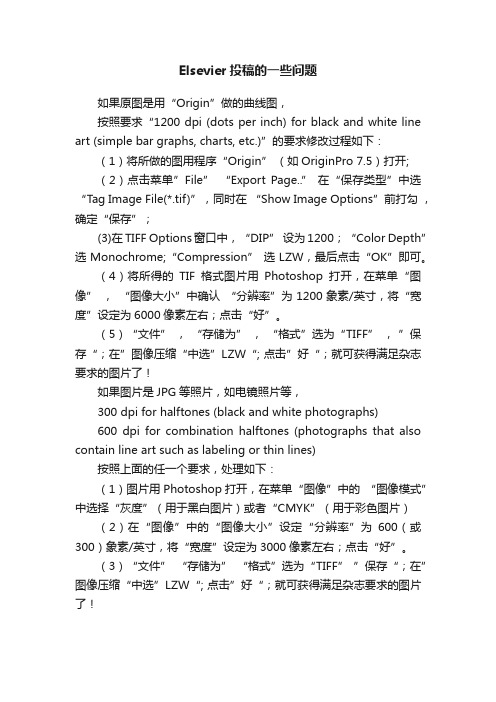
Elsevier投稿的一些问题如果原图是用“Origin”做的曲线图,按照要求“1200 dpi (dots per inch) for black and white line art (simple bar graphs, charts, etc.)”的要求修改过程如下:(1)将所做的图用程序“Origin” (如OriginPro 7.5)打开;(2)点击菜单”File” “Export Page..” 在“保存类型”中选“Tag Image File(*.tif)”,同时在“Show Image Options”前打勾,确定“保存”;(3)在TIFF Options窗口中,“DIP” 设为1200;“Color Depth” 选Monochrome;“Compression” 选LZW,最后点击“OK”即可。
(4)将所得的TIF格式图片用Photoshop打开,在菜单“图像” ,“图像大小”中确认“分辨率”为1200象素/英寸,将“宽度”设定为6000像素左右;点击“好”。
(5)“文件” ,“存储为” ,“格式”选为“TIFF” ,”保存“;在”图像压缩“中选”LZW“; 点击”好“;就可获得满足杂志要求的图片了!如果图片是JPG等照片,如电镜照片等,300 dpi for halftones (black and white photographs)600 dpi for combination halftones (photographs that also contain line art such as labeling or thin lines)按照上面的任一个要求,处理如下:(1)图片用Photoshop打开,在菜单“图像”中的“图像模式” 中选择“灰度”(用于黑白图片)或者“CMYK”(用于彩色图片)(2)在“图像”中的“图像大小”设定“分辨率”为600(或300)象素/英寸,将“宽度”设定为3000像素左右;点击“好”。
elsevier co-authorship of submission to -回复
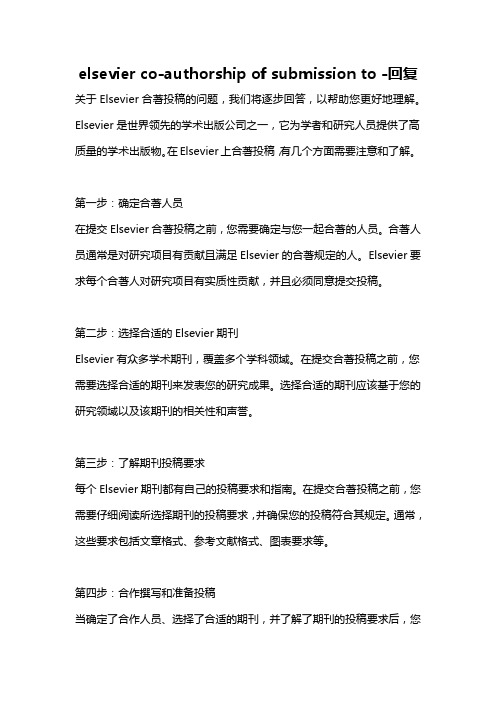
elsevier co-authorship of submission to -回复关于Elsevier合著投稿的问题,我们将逐步回答,以帮助您更好地理解。
Elsevier是世界领先的学术出版公司之一,它为学者和研究人员提供了高质量的学术出版物。
在Elsevier上合著投稿,有几个方面需要注意和了解。
第一步:确定合著人员在提交Elsevier合著投稿之前,您需要确定与您一起合著的人员。
合著人员通常是对研究项目有贡献且满足Elsevier的合著规定的人。
Elsevier要求每个合著人对研究项目有实质性贡献,并且必须同意提交投稿。
第二步:选择合适的Elsevier期刊Elsevier有众多学术期刊,覆盖多个学科领域。
在提交合著投稿之前,您需要选择合适的期刊来发表您的研究成果。
选择合适的期刊应该基于您的研究领域以及该期刊的相关性和声誉。
第三步:了解期刊投稿要求每个Elsevier期刊都有自己的投稿要求和指南。
在提交合著投稿之前,您需要仔细阅读所选择期刊的投稿要求,并确保您的投稿符合其规定。
通常,这些要求包括文章格式、参考文献格式、图表要求等。
第四步:合作撰写和准备投稿当确定了合作人员、选择了合适的期刊,并了解了期刊的投稿要求后,您可以与合作人员一起开始撰写和准备投稿。
在此过程中,您需要确保您的研究成果有清晰的结构和逻辑,包括引言、方法、结果和讨论等部分。
您还需要准备好图表和参考文献等内容,并确保其格式符合期刊要求。
第五步:提交合著投稿一旦您和合作人员完成了文章的撰写和准备工作,您可以开始提交合著投稿。
在提交之前,请再次确保您的文章内容和格式都符合所选期刊的要求。
您可以通过Elsevier的在线投稿系统提交您的投稿,并根据系统的指导完成相关步骤。
第六步:等待同行评审提交合著投稿后,您的文章将进入同行评审流程。
这意味着您的投稿将由匿名的专家评审人员进行评审。
评审人员将对您的研究方法、结果和结论进行评估,并提供您改进和完善研究的建议。
爱思唯尔被拒的审稿意见
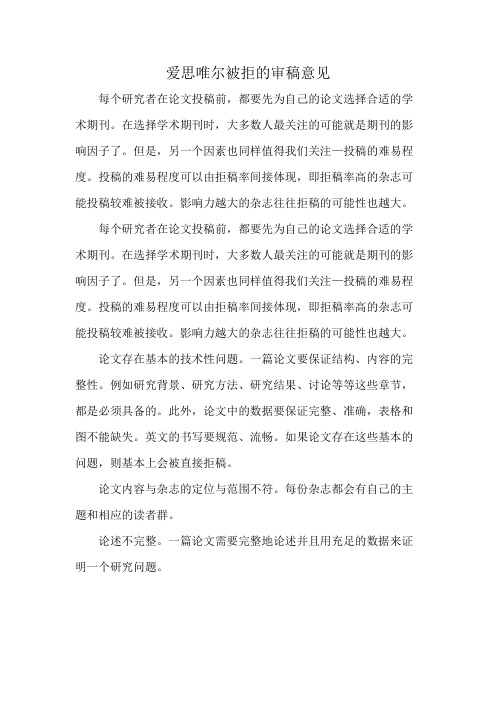
爱思唯尔被拒的审稿意见
每个研究者在论文投稿前,都要先为自己的论文选择合适的学术期刊。
在选择学术期刊时,大多数人最关注的可能就是期刊的影响因子了。
但是,另一个因素也同样值得我们关注—投稿的难易程度。
投稿的难易程度可以由拒稿率间接体现,即拒稿率高的杂志可能投稿较难被接收。
影响力越大的杂志往往拒稿的可能性也越大。
每个研究者在论文投稿前,都要先为自己的论文选择合适的学术期刊。
在选择学术期刊时,大多数人最关注的可能就是期刊的影响因子了。
但是,另一个因素也同样值得我们关注—投稿的难易程度。
投稿的难易程度可以由拒稿率间接体现,即拒稿率高的杂志可能投稿较难被接收。
影响力越大的杂志往往拒稿的可能性也越大。
论文存在基本的技术性问题。
一篇论文要保证结构、内容的完整性。
例如研究背景、研究方法、研究结果、讨论等等这些章节,都是必须具备的。
此外,论文中的数据要保证完整、准确,表格和图不能缺失。
英文的书写要规范、流畅。
如果论文存在这些基本的问题,则基本上会被直接拒稿。
论文内容与杂志的定位与范围不符。
每份杂志都会有自己的主题和相应的读者群。
论述不完整。
一篇论文需要完整地论述并且用充足的数据来证明一个研究问题。
爱思唯尔请来两位审稿牛人分享论文投稿的11处细节

爱思唯尔请来两位审稿牛人分享论文投稿的11处细节当你读一篇文章时,如果发现文中偶尔会犯一两个小错误,或许你还可以容忍。
但如果文章错误百出,那么你一定会丧失继续阅读下去的兴趣。
这一规律放在论文发表上更为适用,因为基本上可以确定,你的学术论文要比一篇散文和随笔枯燥乏味得多。
你想要发表论文,且不说你的论文能否激起审稿人的兴趣,至少要确保不能让审稿人丧失继续阅读你这篇“较为枯燥”的论文的兴趣。
对于时间异常宝贵的审稿人来说,他们需要放弃自己的空闲时间来通读你的论文,然后决定你的论文是否应该发表。
如果他们发现自己看不下去你的论文,结果会怎样?你懂的。
那么,你该如何确定提交的论文没有低级失误,同时还能激起审稿人的阅读兴趣,从而增加轻松通过同行评审的几率呢?为此,爱思唯尔(Elsevier,全球最大的学术出版社之一)出版社特邀了两位经验丰富的审稿人,为大家提供了一些秘诀和建议。
首先有请来自德克萨斯A&M大学(Texas A&M University,美国20大公立科研机构之一,在世界各大学学术与声誉排名中稳居前100名)的荣誉教授Alexandru T. Balaban,他非常热心地分享了7个秘诀:1、单靠自己检查拼写远远不够,你要请精通论文所用语言、熟悉其语法和遣词造句的人来帮助你修改论文(该语言最好为修改人的母语)。
2、仔细查阅所投期刊的投稿指南(Guide for Authors),以及期刊专为论文作者而提供的相关资料。
3、尽量写言简意赅的短句,避免论文啰嗦、冗长。
4、根据概念和观点断句,不要一句一段。
5、论文排版时,注意适当缩进段落!6、指出所附图表在论文中的位置。
对审稿人来说,在论文中的对应位置附上图表非常便于阅读。
不过,许多期刊经常要求作者单独在论文后面附上所有图表,因此当同行评审工作完成、审稿意见采纳后,你再次提交修改的论文时,可能需要按照期刊要求的论文格式重新排版。
7、再次查阅修改完善后的终稿。
- 1、下载文档前请自行甄别文档内容的完整性,平台不提供额外的编辑、内容补充、找答案等附加服务。
- 2、"仅部分预览"的文档,不可在线预览部分如存在完整性等问题,可反馈申请退款(可完整预览的文档不适用该条件!)。
- 3、如文档侵犯您的权益,请联系客服反馈,我们会尽快为您处理(人工客服工作时间:9:00-18:30)。
关于Elsevier旗下期刊投稿1 关于Elsevier旗下期刊投稿概述(1) Elsevier旗下共有1300多种期刊。
投稿时采用的是Elsevier Editorial System (EES)投稿系统(2) 审稿时间。
通常不会超过半年,如果半年时间到,部分审稿意见没有返回,期刊社同样会把已返回的意见返回给你。
(3) 版权问题。
一般会通过给你发几个PDF合同,然后你打印出来,用手填写,然后邮寄或者扫描后通过email发给他们。
(4) 投稿模板。
通常很多人都会关心这个问题,这是投稿的第一步。
但是Elsevier 旗下期刊对投稿的模板没什么要求,只要你比较注意排版,看着舒服就好。
至于排版,录用后他们编辑会排版,然后让你来校正。
建议,投稿时候不要考虑纸张页数,国外期刊不太关心期刊页数,只要按他们最后的排版不超过30页(好像是30页)一般不会收钱。
(5) 如果投稿论文分成几个部分,在投稿的时候就要分开,按照单独的论文投稿。
不过要在Letter to Editor中要说明这是同一个论文。
(6) Elsevier旗下期刊投稿不收取审稿费,发表也不收取版面费,但超过一定页数会适当收取费用,如果用彩色印刷,也会收钱,他们不收则以,一收就比较多。
(7) 投稿时是否需要把图片和论文主题分开。
这个本来不需要说的,网站上的要求就是如此,需要单独分开上传,但是以我的经验,如果论文图太多,特别是对于国内的网速慢,上传很不方便,可以直接把图放在论文中间,审稿阶段不用考虑图文分开,等录用后再图文分开。
2 Elsevier投稿状态总结(1) Submitted to Journal刚提交的状态(2) Manuscript received by Editorial Office就是你的文章到了编辑手里了,证明投稿成功(3) With editor如果在投稿的时候没有要求选择编辑,就先到主编那,主编会分派给别的编辑。
这当中就会有另两个状态:1) Awaiting Editor Assignment指派责任编辑Editor assigned是把你的文章分给一个编辑处理了。
2) Editor Declined Invitation 也可能编辑会拒绝邀请,这就需要重新指定编辑3) technical check in progress 检查你的文章符不符合期刊投稿要求(4) 编辑接手处理后也会有2种状态1) Decision Letter Being Prepared 就是编辑没找审稿人就自己决定了,2) Reviewer(s) invited 找到审稿人了,就开始审稿(5) Under review这应该是一个漫长的等待。
当然前面各步骤也可能很慢的,要看编辑的处理情况。
如果被邀请审稿人不想审,就会decline,编辑会重新邀请别的审稿人。
(6) Required Reviews Completed审稿人的意见已上传,审稿结束,等待编辑决定(7) uating Recommendation评估审稿人的意见,随后你将收到编辑给你的decision(8) Minor revision/Major revision这个时候可以稍微庆祝一下了,问题不大了,因为有修改就有可能。
(9) Revision Submitted to Journal.又开始了一个循环。
(10) Accepted 文章被接受(11) Transfer copyright form 签版权协议(12) uncorrected proof 等待你校对样稿(13) In Press, Corrected Proof 文章在印刷中,且该清样已经过作者校对(14) Manuscript Sent to Production 排版(15) in production 出版中备注:现在Elsevier的绝大多数期刊,增加了Technical Checking这一关,由专门的Editorial office来审查论文的语言、格式、排版、图片等等,也就是说,审查你的投稿是否符合Guide for Authors中的各项要求。
论文投稿之后,状态是Submitted to Journal,后成为with editor。
注意:这里的Editor实际上不是期刊的主编,而是Editorial office里负责论文格式、排版、语言审查的编辑。
如果论文通过了技术性审查,状态重新变为Submitted to Journal,表明论文通过了第一关。
之后,如果不出意外,论文状态将会再次变成With Editor,这里的Editor才是真正的期刊主编。
到了这一步,你的论文才会进入under review状态。
需要说明的是,如果你的论文没通过Technical Checking这一关,你的论文就会退回,要求做格式、语言上的修改,然后鼓励你再投。
直播在elsevier上投稿,与大家一起分享遇到的问题并解答最近在Elsevier的TALANTA投稿,直播一下自己遇到的问题,并与大家分享解决的过程。
首先,Elsevier支持完全的在线投稿。
其次,需要现在Elsevier注册帐户才能上传文章。
第三,上传文章包括上传作者、题目、摘要、文章类型选择(全文、简报等)投稿上传的文件中包括cover letter(相当于文章的介绍信)、novelty statement(文章的创新性声明)、Manuscript(论文正文)、List of Three Potential (Reviewersreviewer suggestions,推荐的审稿人,一般是3个人)、Figure(s)(文中出现的图)Table(s)(文中出现的表)、Checklist (上传的文件清单)等几项,其中前三项必须有,后面几项可有可无。
第四,上传完各个文件之后,Elsevier会在线生成一个PDF文档(也就是你的文章),仔细检查生成的pdf文档,包括作者、图表的顺序等注意事项:1.关于文中的图片,不能镶嵌于正文中(否则在线生成的pdf文档中会出现两次的图片),必须单独上传,另外格式仅限于EPS、TIF、JPEG等。
2.添加作者的时候,注意联系作者默认是第一位,可能需要适当调整。
Elsevier投稿要求(适用所有期刊)发布时间:2008年06月11日00:00:00 浏览次数:2821. 首页内容:题目,作者,单位及地址,通讯联系人及联系方式 2. 次页:摘要及5-10个关键词 3. 格式要求:A4纸,双倍行距,字号不小于11,总页数少于30页(含图、表及参考文献) 4. 可以使word或者pdf格式sci投稿图片处理2009-08-13版权声明:转载时请以超链接形式标明文章原始出处和作者信息及本声明/logs/44099315.html转载/logs/42102566.html杂志社对投稿图片的分辨率通常有如下要求:TIFF: Colour or greyscale photographs (halftones): always use a minimum of 300 dpi.TIFF: Bitmapped line drawings: use a minimum of 1000 dpi.第一点说的是灰度图的dpi在至少300dpi以上,比如病理图片、电泳图等;第二点说的是点阵线性图的分辨率一般在1000dpi以上,比如用excel所作曲线或柱状图,chemdraw所画结构式等。
投稿所遇到的问题:通常数码照片的dpi为72而excel所作图片的dpi为200均不能满足投稿需求,因此要更改dpi 设置解决方法:在photoshop新建一个A4格式的图片,在图片大小选项中将分辨率选为杂志所需的分辨率(比如1000ppi,这里可能又涉及到一个ppi和dpi的概念,其实你不用多管,简单说来,一个相当于电脑屏幕的输出(ppi),一个相当于打印机的输出(dpi),你只要ppi设为1000,打印的分辨率就为1000dpi,两者在数值上是等量的)。
将excel或照片直接粘贴到新建图层中(注意,这是的图片显示的可能会很小),将图片放大到适合观看的大小,剪切所需区域,如果杂志社对图片大小有要求可以通过图片大小选项设定(例如5cm*3cm),保存为tiff格式,将保存layer前的对钩去掉,确定,采用LZW压缩,确定,即可。
这样保存的图片大约为200k.dpi增大的优点:通常我们用excel作的图贴到word或直接保存为图片,会发现,图片缩小会比较清初,但是放大后遍模糊将dpi增大后,虽然缩小图片感觉不如直接保存清初,但是你放大很多倍后图像仍清晰以上是在LaoLang_cool战友的帮助下完成dpi修改过程中的一些体会,整理出来供大家分享。
(转自dxy, 由gaalaa 版主整理提供)如果原图是用“Origin”做的曲线图,按照要求“1200 dpi (dots per inch) for black and white line art (simple bar graphs, charts, etc.)”的要求修改过程如下:(1)将所做的图用程序“Origin”(如OriginPro 7.5)打开;(2)点击菜单”File”“Export Page..”在“保存类型”中选“Tag Image File(*.tif)”,同时在“Show Image Options”前打勾,确定“保存”;(3)在TIFF Options窗口中,“DIP”设为1200;“Color Depth”选Monochrome;“Compression”选LZW,最后点击“OK”即可。
(4)将所得的TIF格式图片用Photoshop打开,在菜单“图像”,“图像大小”中确认“分辨率”为1200象素/英寸,将“宽度”设定为6000像素左右;点击“好”。
(5)“文件”,“存储为”,“格式”选为“TIFF”,”保存“;在”图像压缩“中选”LZW“; 点击”好“;就可获得满足杂志要求的图片了!如果图片是JPG等照片,如电镜照片等,300 dpi for halftones (black and white photographs)600 dpi for combination halftones (photographs that also contain line art such as labeling or thin lines)按照上面的任一个要求,处理如下:(1)图片用Photoshop打开,在菜单“图像”中的“图像模式”中选择“灰度”(用于黑白图片)或者“CMYK”(用于彩色图片)(2)在“图像”中的“图像大小”设定“分辨率”为600(或300)象素/英寸,将“宽度”设定为3000像素左右;点击“好”。
